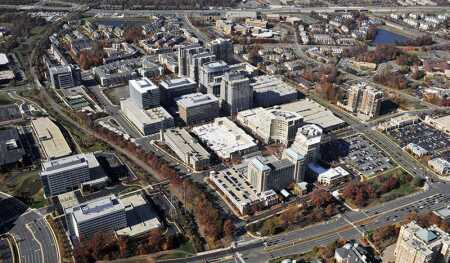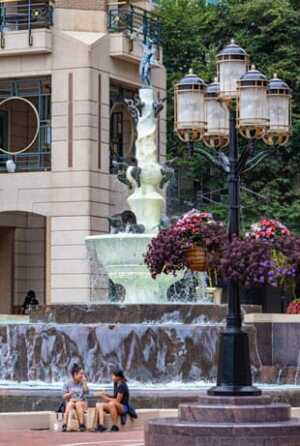This article appeared in the Fall issue of Urban Land on page 164.
Two towers will soon rise over Reston Town Center in a kind of giant architectural sculpture, joined at the seventh floor and rising 20 stories above the city blocks around them.
“That’s going to be very dramatic—the way those buildings create a monumental opening,” says Alan Ward, a principal with design firm Sasaki, based in Watertown, Massachusetts. (Read more from Sasaki’s Alan Ward on the success of Reston Town Center.)
The new towers may seem more appropriate for an ambitious, growing city than a suburban area in Northern Virginia’s Fairfax County. But over time Reston Town Center has evolved from a series of grand concepts drawn up by architects, to a few blocks of office buildings, to something very much like a successful urban neighborhood—which is soon to have its own stop on the Metrorail system serving the Washington, D.C., metropolitan area. With each phase in its evolution, the development has become more dense, the mix of uses has become more varied, and the real estate has become more valuable.
“You are achieving densities that are associated with traditional downtowns,” says Ward, who has been working on Reston Town Center since the mid-1980s.
Reston Town Center’s Third Phase
In October 2018, workers started building 1.1 million square feet (102,000 sq m) of new office space at Reston Town Center. Boston Properties plans to open the first of these office spaces in the first half of 2022.
The first major tenant already has signed up. Secondary mortgage–market giant Fannie Mae will lease about 850,000 square feet (79,000 sq m) of office space at Reston Town Center for its new regional hub, according to Fairfax County officials. The third phase of development at Reston Town Center also will include retail space, a new select-service hotel, and an apartment building with 500 units, for a total of as much as 4.5 million square feet (418,000 sq m) of space.
Reston Town Center is growing again as workers finish a long-planned extension of the Metrorail transit system. The expanded Silver Line will eventually run 23 miles (37 km) between Dulles International Airport and downtown Washington and onward to the Maryland suburbs.
Reston’s new stop on the Silver Line is scheduled to open in 2020. Workers are building the new station on an island between the eastbound and westbound lanes of the Dulles Toll Road, just a few minutes’ walk from Fountain Square, the heart of Reston Town Center. Pedestrian bridges will connect the Metro station to streets and sidewalks nearby.
Boston Properties also is planning a series of new public spaces, totaling seven acres (2.8 ha). That includes a long, narrow Central Park that will guide visitors from the new Metro station, across the new urban street grid that Boston Properties is creating, to the existing blocks comprising Reston Town Center.
Decades of Evolution
Reston is a census-designated place in Fairfax County. It has no mayor or civic government of its own, though it had a substantial population of 60,070 as of December 2017, according to the U.S. Census Bureau. It is the kind of place that has its own museum—the Reston Historic Trust and Museum—dedicated to telling the story of its origins and the philosophy of its founder, Robert E. Simon. (The first letters of the Reston’s name come from his initials.)
Simon also gave Reston its motto: “Work, Play, Live.” Visitors to Reston’s museum can find the updated version of that catchphrase, “Live, Work, Play,” emblazoned on merchandise from T-shirts to toddler onesies. The phrase has caught on in cities and town centers across the United States where planners, new urbanists, and mixed-use developers also celebrate their walkable, master-planned communities as places where residents and visitors can live, work, and play.
“Simon had the forethought to deliver a mix of uses,” says Pete Otteni, senior vice president in the Reston office of Boston Properties. He has worked on Reston Town Center much of his career.
Simon also wanted Reston to be open to people of all ages, incomes, and ethnicities. “He wanted lots of different kinds of housing and lots of different levels of affordability,” says Otteni. “Reston was one of the first racially integrated developments in Virginia, which was pretty forward thinking for the 1960s.”
In 1961, Simon paid $1,500 per acre ($3,700 per ha) for 6,750 acres (2,700 ha) of largely wooded farmland close to Dulles airport, which was then under development.
He had big ideas for the site, including a master plan from the firm of Whittlesey & Conklin (later Conklin Rossant). In 1962, the Fairfax County Board of Supervisors approved an unusually flexible residential planned community zoning for the site that allows mixed-use, mixed-density development.
The master plan left room for some kind of mixed-use town center in the heart of Reston. “At the time there was a fascination with arcades,” says Ward, who is the editor of Reston Town Center: Downtown for the 21st Century, published in 2006 by Academy Press. His book details several of the early plans for Reston’s town center, including several proposals to build large-scale, enclosed malls inspired by shopping arcades.
“It’s fortunate that those weren’t built,” says Ward. “A single massive building is relatively difficult to adapt to the changing needs of the times and it is not easy to undo agreements with anchor tenants.”
The first phase of Reston Town Center opened in the early 1990s. By then Simon had long since sold his controlling interest in Reston to his investment partners, Gulf Reston, an investment subsidiary of Gulf Oil. In turn, Gulf Reston, sold to Reston Land Corp., a subsidiary of Mobil Oil Corp., which built the first phase of Reston Town Center.
Seen from the air, Reston Town Center is unlike anything nearby, with streets at right angles to each other in a traditional grid and blocks that are not much more than 100 or 200 feet long or wide (30 to 61 m). “When you have these simple blocks at the right scale, the development can grow and evolve over time,” says Ward. The developers resisted the urge to create extra-large or extra-small blocks that might be difficult to redevelop to new uses.
Reston Land filled this street grid with 500,000 square feet (46,500 sq m) of office space and 250,000 square feet (23,000 sq m) of retail space, largely arranged along Market Street. The developer also partnered with Hyatt Regency to open a 500-key hotel on Market Street overlooking Fountain Square, the public space at the heart of the town center. Reston Land provided parking on parking decks and surface parking lots, largely on the edges of the street grid.
Developer Boston Properties opened more than 1.6 million square feet (149,000 sq m) of office and retail space at Reston Town Center between 1999 and 2009. This second phase of development extended the street grid several blocks to the west with 1,700 rental apartments and condominiums developed by Trammell Crow Residential; McLean, Virginia–based Kettler; and Boston Properties.
“The building uses have evolved from an office-dominated urban core with a hotel and retail to a more balanced mix of uses—with a significant range of residential,” says Ward.
The developers also altered the original master plan for the town center, which called for Market Street to end with a second large hotel after a few blocks, like an open-air version of a classic shopping mall with anchor tenants on each end. Instead, the developers extended Market Street into the new blocks of apartments and condos. “This gave the feel of a traditional American city built on an expansive grid that extends into different neighborhoods . . . less like a planned project that was closed in and contained,” says Ward.
“We have been very thoughtful over years how to prioritize walkability,” says Boston Properties’ Otteni. That also includes how the developers arranged buildings along the sidewalks of Market Street. “We placed parking and loading dock entrances deep into the development . . . further back and not in your faces.”
That allowed the developers to line the main streets of the town center with an unbroken chain of shops and restaurants. The open street grid of the growing town center also allows new retail districts to evolve, following the preferences of where Reston’s workers and visitors liked to walk—such as the strip of restaurants that grew along Democracy Drive, just south of Market Street.
“The outdoor dining proved to be very popular,” says Ward.
The Reston Town Center retail spaces are fully occupied. “There is currently only a small, 2,200-square-foot [200 sq m] space available, but not yet vacant,” says Nicholas Mills, market analyst at CoStar Group. “The occupancy rate has been steadily at 95 to 100 percent since the start of 2017. Any time space becomes available, it is quickly leased.”
Largely because of the variety of these retail spaces, Reston Town Center earns a “very walkable” rating of 88 out of 100 points from WalkScore.com for the area immediately around the fountain. “This location is Very Walkable, so most errands can be accomplished on foot,” according to site.
Because the town center is so friendly to pedestrians, the people who live and work there make about 30 percent fewer trips by car compared with people living in more typical suburban areas that have buildings on individual parcels, Ward says. “That is what has made it a valuable place to live, work, and invest: it is the pedestrian life.”
Once workers or visitors come to Reston Town Center, they can often accomplish more than one errand. The retail spaces are fed by a constant stream of people walking to and fro on the sidewalks that crisscross the development in different directions—helping nourish the retail spaces with a steady flow of foot traffic.
In comparison, workers at suburban office parks typically have fewer amenities within walking distance. “Young employees are reluctant to work in an isolated suburban office property with nothing around it,” Ward notes.
Boston Properties currently owns 5 million square feet (465,000 sq m) of space in Reston, including nearly all the commercial real estate in its urban core. As of July 2019, the office space at Reston Town Center was 91.3 percent occupied, with gross rents averaging $34 per square foot ($366 per sq m), according to CoStar. That is a much better performance than for comparable office properties in the area—even those that now benefit from being within easy walking distance of the Wiehle-Reston East Metro station that opened in 2014 and is, for the time being, the last stop on the Silver Line.
“The office spaces at Reston Town Center are more than a mile [1.6 km] from the current end of the Silver Line, and rents and occupancies are above properties located closer,” says Mills.Looking Forward
Over time, the real estate at Reston Town Center has become more valuable and able to support more density. And developers have taken advantage of this demand by developing on the surface parking lots that once took up space on the edges of the town center.
Boston Properties recently tore up the last remaining surface lot in the original town center and built an apartment tower with a 20,000-square-foot (1,900 sq m) grocery store on the ground floor. The 508 luxury apartments opened in February 2018 with asking rents of $3,200 per month, or $2.90 per square foot ($31.22 per sq m). As of mid-July, the apartments were already 70 percent occupied, according CoStar.
“In the project’s first year of delivery, one to two months of free rent were prevalent, but those concessions have since burned off,” says Mills.
The growing demand for space in Reston Town Center has motivated Boston Properties to undertake its first redevelopment in Reston’s urban core. The developer tore down a three-story office building just off Fountain Square and is replacing it with 17FIFTY, a 17-story tower with 275,000 square feet (26,000 sq m) of office space, which will become the corporate headquarters of Leidos, an information technology company.
With more glass cladding, the architecture of these new buildings looks a little different from the style of older buildings in the town center. That helps Reston Town Center feel more like what it has become: an urban neighborhood that has grown and evolved over time.
The new buildings at Reston Town Center also rise higher than the older buildings around them. “No one could foresee the densities that we are building today back when those plans were done,” says Ward. “No one thought you could do mid-rise or high-rise residential in the suburbs.”
The new Metro station coming to Reston also would have seemed impossible a few decades ago. “The densities were so low in the suburbs that it has taken a long time to get the critical mass to justify transit,” says Ward.
The space between the older blocks of the existing Reston Town Center and the new Metro station is occupied largely by surface parking lots, which are relatively easily to redevelop. These lots are separated from the town center by the Washington & Old Dominion Trail, a walking and biking path set in a ravine along an old rail line. Boston Properties will build a series of bridges and walkways to extend the streets of the earlier phases of the town center over the scenic trail into the new phase of city blocks.
The new, urban city blocks of Boston Properties’ phase three will be the densest development yet at Reston Town Center, offering a series of possibilities for growth and adaptation. “The new mass transit station will shift the center of gravity of the town center southward,” says Ward.






![Western Plaza Improvements [1].jpg](https://cdn-ul.uli.org/dims4/default/15205ec/2147483647/strip/true/crop/1919x1078+0+0/resize/500x281!/quality/90/?url=https%3A%2F%2Fk2-prod-uli.s3.us-east-1.amazonaws.com%2Fbrightspot%2Fb4%2Ffa%2F5da7da1e442091ea01b5d8724354%2Fwestern-plaza-improvements-1.jpg)


